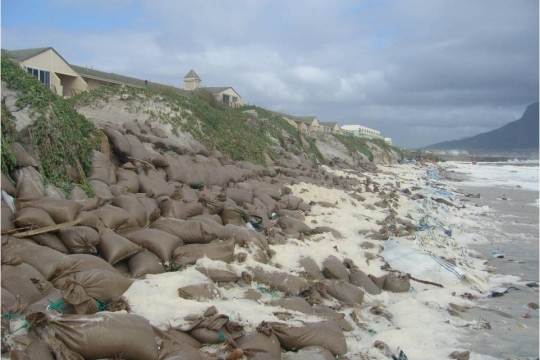CAPE TOWN, SOUTH AFRICA: When home owners at a seaside residential complex in Milnerton, Cape Town, decided to pile up sandbags between the beach and their gardens in the early 2000s, their intention was to stop the high tide from eating away at their plots during storm surges. What they didn’t anticipate was that this erosion control measure would make their property prices fall, reduce beach space, drive away tourists, and leave the beach strewn with litter.
Planning for the unintended fallout of efforts to offset the impact of climate change - so-called ‘maladaptation’ to climate change - is a relatively new concept in the field of climate change adaptation, according to researchers. They argue that a better conceptual outline is needed of what precisely maladaptation is, and that decision makers and stakeholders need a strong set of guidelines to help avoid these unintended consequences.
In the Milnerton case, the idea was to protect private property as storm surges and sea level rise eroded low-lying land in a particularly high-risk part of the City of Cape Town’s coastline. And the decision to shore up the beach with sandbags was made by private property owners. But the impact was felt by the wider community: the sandbags weren’t made from UV-resistant materials, so they soon broke down and littered the beach with strings of plastic weaving; the bags collapsed, reducing the beach’s size and cutting off people’s access. Tourism revenue across the bay area dropped, and the property prices fell as the place lost its appeal.
‘In this case, even if erosion was held at bay, the presence of the sandbags showed how a local response to erosion can threaten the entire public coastal zone,’ argues Ass Prof Gina Ziervogel, a research fellow with the University of Cape Town’s Environmental Policy Research Unit (EPRU). ‘This prompts questions about city planning, and about decisions to allow this kind of development to go ahead.’
Ziervogel, who is based at the university’s Department of Environmental and Geographical Science, recently co-authored a paper on maladaptation in the context of climate change response.
The authors outline the need for researchers and planners to be aware of the risks associated with the unintended consequences of well-intentioned climate change actions. The paper also helps formulate guidelines that could steer decision makers so they can plan for, or avoid, the possible negative implications of their climate change strategies.
According to Ziervogel and her co-authors, in the context of climate change response, maladaptation refers loosely to actions taken with the intention of avoiding or reducing vulnerably to climate change, but which impact negatively on, or increase the vulnerability of, other systems, sectors or social groups.
The authors argue that this field of thinking should also involve a focus on resilience.
‘Building resilience to a specific hazard may come at the cost of building resilience to other hazards,’ they argue.
Another example which they cite is from Nepal, where farmers dug ponds into a dry riverbed so they could pump groundwater for their crops during a drought in 2010. But once the rains came, and the river filled again, the deformed beds caused the river to flow differently, resulting in widespread flooding and damage to their farmlands.
The authors argue that avoiding maladaptation starts with an intention to avoid mistakes or locked-in negative effects of climate responses, and that the concept and guidelines need to be fleshed out further.
 Sandbags used to stop tidal erosion along a stretch of coast in Cape Town caused a number of unexpected problems.
Sandbags used to stop tidal erosion along a stretch of coast in Cape Town caused a number of unexpected problems.
PHOTO CREDIT: © City of Cape Town
‘This must become a priority for decision makers and stakeholders, from the international to the local levels.’
The paper, Addressing the risk of maladaptation to climate change, which was published online in the journal WIREs Climate Change in May 2016, was dedicated to the five babies who were in utero amongst the authors or authors’ partners during the time of writing.
‘We thought it was a nice dedication,’ concludes Ziervogel, who was pregnant with her daughter Faye at the time, ‘because we saw it as a call for us to address maladaptation so our children don’t bear the cost.’
